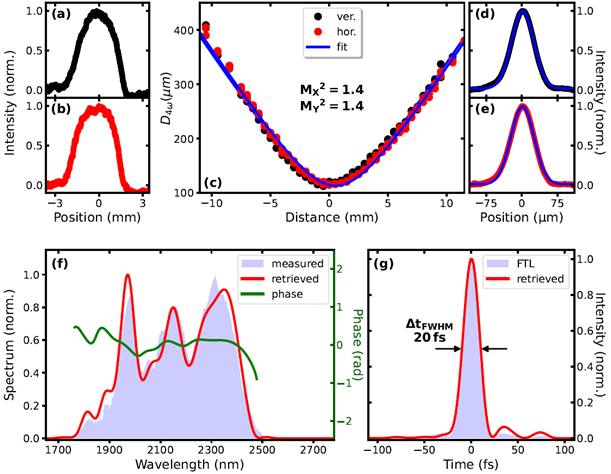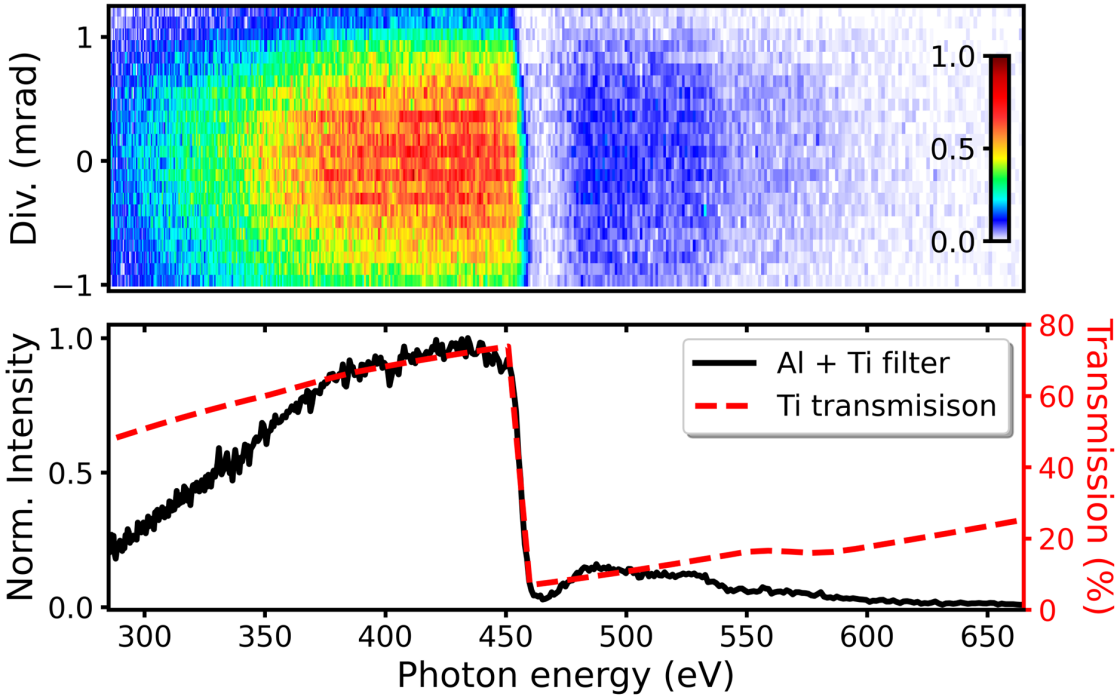Institute for Electronic Structure Dynamics
The Liquid & Interfacial Dynamics with Ultrafast X-rays (LIDUX) Facility
Within the Liquid & Interfacial Dynamics with Ultrafast X-rays (LIDUX) group we are developing and applying state-of-the-art infrastructure to enable ultrafast-time-resolution, bulk and interfacial condensed-phase electronic structure measurements. Through a combination of few-femtosecond time-resolution and the element-, electronic-state-, and chemical-environment-selectivity afforded by soft X-ray spectroscopy, table-top experimental probes of evolving molecular and material structure will be facilitated at the limiting temporal and spatial scales of chemistry.

The LIDUX laboratory laser room
These probes will be applied to understand, and potentially control, the dynamics and mechanisms of:
- physicochemical and photobiological processes,
- the early stages of homogeneous and heterogeneous photocatalysis, as well as
- charge separation, recombination, transfer, and propagation phenomena in and at the interfaces of condensed phase samples.
Laboratory Overview

LIDUX Laboratory schematic.
Yb:YAG: Ytterbium:Yttrium Aluminium Garnet, RGA: ReGenerative Amplifier, NIR: Near-Infrared, IR: Infrared, MIR: Mid-Infrared, OPCPA: Optical Parametric Chirped-Pulse Amplifier, HHG: High-Harmonic Generation, fs-OPA/NLO: femtosecond-Optical Parametric Amplifier/Non-Linear Optics, Diagn.: Diagnostics, SFG/DFG: Sum Frequency Generation/Difference Frequency Generation
The realization of the LIDUX laboratory involves four principal challenges:
1. Laser Systems
We adopt and develop next-generation, high-average-power, high-repetition-rate ultrashort pulse laser systems with the aim of producing a spectroscopically useful source of attosecond to few-femtosecond duration soft X-ray pulses. Specifically, a 500 W, 850 fs-pulse-duration thin-disk Yb:YAG regenerative amplifier (RGA) laser with a 53 kHz repetition rate is applied as an ideal pump laser source for our exceptionally high power (>50 W) few-cycle, carrier-envelope-phase stable, short-wave-infrared (SWIR) optical parametric chirped-pulse amplification (OPCPA) laser system, which is used to generate ultrashort, coherent soft X-ray pulses.

LIDUX SWIR-OPCPA laser characteristics measured after ~5 m of propagation to the X-ray generation chamber.
(a) Vertical and (b) horizontal SWIR beam profiles measured after a 3:1 demagnifying telescope. (c) Beam caustics of the uncompressed SWIR pulses along the vertical (y, black) and horizontal (x, red) directions, as measured using a 300 mm-focal-length lens. The blue lines are the fits used to determine M2. (d) and (e) respective y- and x-axis intensity profiles at the 0 mm position shown in (c), i.e., at the beam waist. The blue solid lines are Gaussian fits to the profiles. (f) and (g) Self-Referenced Spectral Interferometry spectro-temporal characterizations of the compressed SWIR pulses.
The LIDUX laser systems and a range of non-linear optical techniques are utilized to produce tuneable, inherently synchronized, few-femtosecond pulses spanning the SWIR to soft X-ray spectral range. The generated pulses are ideally suited for utilization in high-time-resolution, high-data-acquisition-rate, pump-probe experiments.
2. Ultrashort Pulse VUV, EUV, & Soft X-ray Generation
We utilize gas-phase high harmonic generation (HHG) – driven by ultrashort laser pulses in the UV, NIR, or SWIR spectral ranges – to produce ultrashort vacuum ultraviolet (VUV), extreme ultraviolet (EUV), or soft X-ray pulses. This non-perturbative, extreme non-linear optical phenomenon intrinsically generates spatially and temporally coherent ionizing EUV and soft X-ray radiation that is particularly well suited to ultrafast time-resolved spectroscopy and imaging applications. With the aim of maximizing ultraviolet-to-VUV and SWIR-to-soft-X-ray radiation conversion efficiencies and the associated ionizing radiation fluxes, we are actively researching optimum generating gas density profiles and driving laser conditions.
Water-window spanning soft X-ray high-harmonic generation spectra produced in a helium gas cell (~2 mm cell thickness, 9 bar backing pressure) using the LIDUX SWIR OPCPA laser system.
Accordingly, our developed secondary (HHG) laser sources are expected to produce EUV and soft X-ray fluences of 1014-16 photons s-1 and 1010-11 photons s-1 in broadband spectral ranges spanning 10-100 eV and 100-600 eV, respectively.
3. Characterisation, Manipulation, & Utilisation of Ultrashort X-ray Pulses
By driving the HHG process with few-cycle laser pulses, we generate isolated attosecond pulses or few-femtosecond duration attosecond pulse trains. The time-domain structure of this radiation corresponds to respective continuous or comb-like profiles in the frequency domain. To analyse the temporal structure of such radiation, we utilize cross-correlation-based techniques, employing additional, pre-characterised few-cycle optical pulses. To analyse the spectral properties of the generated EUV and soft X-ray light, we employ photoelectron spectroscopy or single-shot, ultra-broadband EUV/soft X-ray photon spectrometer systems.
The generated and characterized ultrashort, ultra-broadband EUV and soft X-ray pulses are excellently suited to single-shot, time-resolved EUV and soft X-ray absorption spectroscopy (TR-XAS) experiments. By carefully ‘monochromatizing’ such light sources, femtosecond time-resolved EUV and soft X-ray photoelectron spectroscopy (TR-XPS) experiments will also be enabled. To facilitate such applications, the high-intensity HHG driving laser must be filtered from the useful VUV, EUV, or soft X-ray radiation and the generated ionizing radiation must be manipulated (at least refocused) for utilization in experiments. A primary challenge is achieving both of these things while maintaining ultrashort pulse durations and maximizing the transfer efficiency of the generated EUV or soft X-ray light to experiments. We are co-developing and applying novel, bespoke, high-efficiency X-ray optical assemblies with WI-AOS to address these challenges and to bring the LIDUX facility into operation.
4. Soft X-ray Spectroscopy & the Push Towards Few-Femtosecond Time-Resolution
We have a keen interest in the electronic structure of liquid water and aqueous solutions within our research group and have a particular focus on developments and applications of the liquid microjet photoelectron spectroscopy (LJ-PES) technique. We enjoy a close collaboration with the research group of Bernd Winter (Fritz-Haber Institut, FHI, Berlin) and perform energy-resolved LJ-PES experiments at a number of synchrotron light sources (BESSY II, PETRA III, and SOLEIL). Following the LIDUX laboratory commissioning phase, a range of such energy-resolved LJ-PES experiments will be facilitated in-house in the VUV, EUV, and lower soft X-ray range. Furthermore, ultrafast TR-XPS and TR-XAS experiments will be enabled, allowing ultrafast physicochemical transformations and their associated mechanisms to be interrogated in real-time.
Upon completion, the LIDUX facility is expected to yield a flexible, table-top light source with the following characteristics:
- Sub-15 fs, tuneable pump pulses spanning 0.4-8.0 eV photon energies
- Energy tuneable 1 fs-15 fs duration probe pulses spanning 25-600 eV (inherently synchronised to the pump pulses mentioned above)
- ~25 µm EUV and soft X-ray focal spot sizes (at 1/e2)
- <15 fs time resolution modes for TR-XPS with ~400 meV energy resolutions and 1 fs to 3 ns pump-probe delay ranges
- Sub-10-fs time-resolution TR-XAS mode of operation with up to 2000 resolving powers (ΔE/E) and 1 fs to 3 ns pump-probe delay ranges
- 1014-108 photons s-1 eV-1 between 25-600 eV (in a monochromatized or broadband mode)
- 1012-13 (average) / 1022-23 (peak) photons s-1 mm-2 mrad-2 (0.1% bandwidth)-1 brilliances at 400 eV
- All at a 53 kHz repetition rate
Collectively, the LIDUX facility will offer a relatively inexpensive, more readily accessible alternative to X-ray free electron laser facilities in situations where linear, ultrafast time-resolution probe techniques (e.g., TR-XPS and TR-XAS) are required for the interrogation of condensed phase samples.

LIDUX Laboratory beamline construction.
Timeline & Current Status
A staged commissioning approach is adopted in bringing the LIDUX facility into operation. First femtosecond-time-resolved XPS experiments are planned in 2025, with related femtosecond-time-resolved XAS infrastructures becoming available in 2026 and 2027.
With the bespoke laboratory space in place and majority of our laser systems now installed and tested, we are currently optimising our soft X-ray sources and commissioning our soft X-ray beam lines for use from 10-600 eV.
Publications
- Quantum-beat photoelectron-imaging spectroscopy of Xe in the VUV.
- Do water's electrons care about electrolytes?
- Vacuum ultraviolet excited state dynamics of the smallest ring, cyclopropane. II. Time-resolved photoelectron spectroscopy and ab initio dynamics.
- Excited state wavepacket dynamics in NO2 probed by strong-field ionization.
- Time-resolved multi-mass ion imaging: Femtosecond UV-VUV pump-probe spectroscopy with the PImMS camera.
- Ultrafast Molecular Frame Electronic Coherences from Lab Frame Scattering Anisotropies.
- The electronic structure of the aqueous permanganate ion: aqueous-phase energetics and molecular bonding studied using liquid jet photoelectron spectroscopy.
- Low-energy constraints on photoelectron spectra measured from liquid water and aqueous solutions.
- Accurate vertical ionization energy and work function determinations of liquid water and aqueous solutions.
- A quantum molecular movie: polyad predissociation dynamics in the VUV excited 3pσ2Σu state of NO2.
- Following in Emil Fischer's Footsteps: A Site-Selective Probe of Glucose Acid-Base Chemistry.
- Quantitative electronic structure and work-function changes of liquid water induced by solute.
- Photoelectron circular dichroism in angle-resolved photoemission from liquid fenchone.
- Probing the molecular structure of aqueous triiodide via X-ray photoelectron spectroscopy and correlated electron phenomena.
- Probing aqueous ions with non-local Auger relaxation.
- Absolute Electronic Energetics and Quantitative Work Functions of Liquids from Photoelectron Spectroscopy.
- Time-stretched multi-hit 3D velocity map imaging of photoelectrons
- Valence and core photoelectron spectra of aqueous I3- from multi-reference quantum chemistry
- Radiation damage by extensive local water ionization from two-step electron-transfer-mediated decay of solvated ions
- Ultrafast Molecular Frame Quantum Tomography
- How to measure work functions from aqueous solutions
- Attosecond formation of charge-transfer-to-solvent states of aqueous ions probed using the core-hole-clock technique
- Complete 3D photoelectron momentum vector reconstruction from time-position charged particle imaging
- High-average-power, few-cycle, 2.1 µm OPCPA laser driver for soft-X-ray high-harmonic generation


